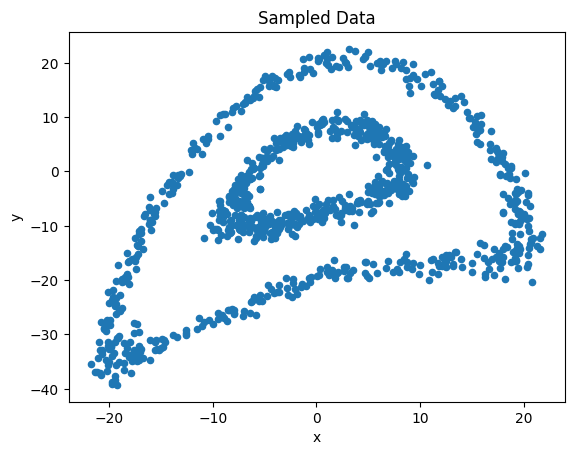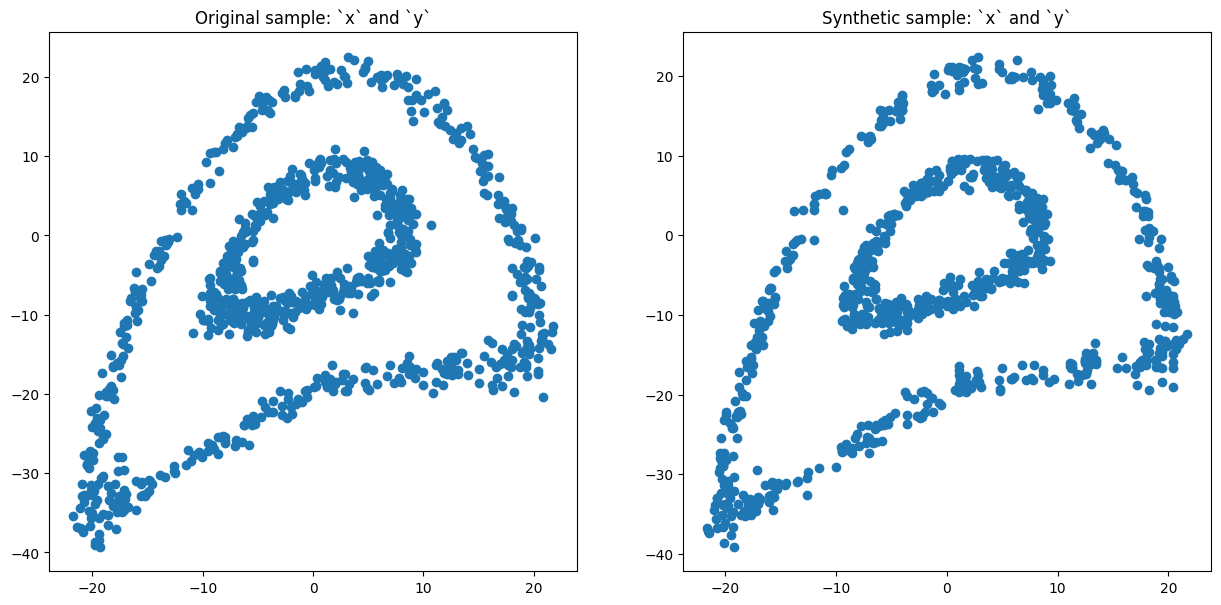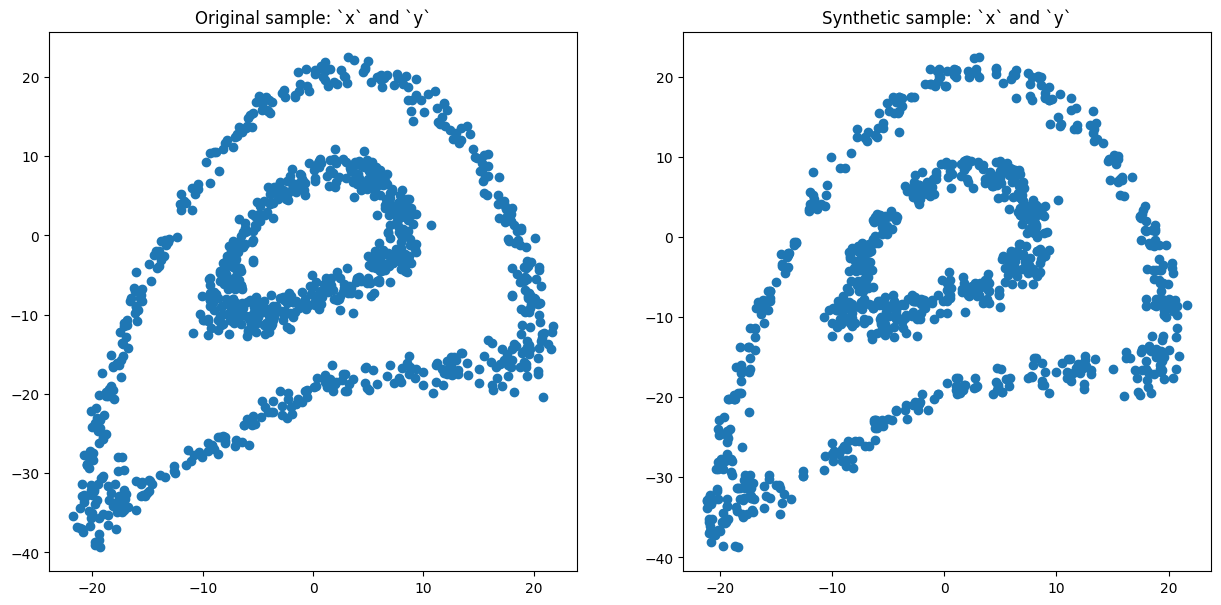Custom Models with synloc: Using Copulas for Synthetic Data Generation
The synloc package empowers users to create synthetic datasets by leveraging custom statistical distributions. While synloc supports a wide range of parametric and nonparametric models, one of the most powerful and flexible approaches is the use of copulas—statistical tools that model complex dependencies between variables.
What does this notebook demonstrate?
Build and use custom synthetic data generators in
synloc.How to extend
synlocwith your own custom distribution classes, using both k-nearest-neighbor and clustering-based resampling strategies.How to integrate copula-based models (specifically, Gaussian copulas via the
synthiapackage) into thesynlocframework to generate realistic synthetic data that preserves multivariate relationships.Guidance on best practices for subclassing
kNNResamplerandclusterResamplerto implement your own synthetic data generation logic.
The custom model template for kNNResampler
Here is the template to utilise kNN Resampler:
from .kNNResampler import kNNResampler
from .tools import stochastic_rounder
from pandas import DataFrame
class myDistributionWithkNN(kNNResampler):
"""
Base class for k‐nearest‐neighbor synthetic data generators.
:param data: Original dataset to synthesize from
:type data: pandas.DataFrame
:param K: Number of neighbors for each synthetic draw (default: 30)
:type K: int, optional
:param normalize: Whether to normalize before neighbor search (default: True)
:type normalize: bool, optional
:param clipping: Clip outputs to the original data range (default: True)
:type clipping: bool, optional
:param Args_NearestNeighbors: Extra kwargs for sklearn.neighbors.NearestNeighbors
:type Args_NearestNeighbors: dict, optional
"""
def __init__(
self,
data: DataFrame,
K: int = 30,
normalize: bool = True,
clipping: bool = True,
n_jobs: int = -1,
Args_NearestNeighbors: dict = {}
):
super().__init__(data, self.method, K, normalize, clipping, n_jobs, Args_NearestNeighbors)
def method(self, subsample: DataFrame):
"""
Abstract method: generate a single synthetic sample from a kNN subsample.
:param subsample: DataFrame of the K nearest neighbors
:type subsample: pandas.DataFrame
:return: One synthetic observation (array-like or pandas.Series)
"""
raise NotImplementedError("Subclasses must implement `method`")
def round_integers(
self,
integer_columns: list,
stochastic: bool = True
) -> None:
"""
Round specified columns of the generated sample to integers.
:param integer_columns: List of column names to round
:type integer_columns: list of str
:param stochastic: If True, use stochastic rounding; else deterministic
:type stochastic: bool, optional
"""
if not self.fitted:
print("No synthetic data yet—call `.fit()` first.")
return
# Leverage parent’s rounding routine
super().round_integers(integer_columns, stochastic)
Let’s install a python package named synthia to use their copulas:
[2]:
from synloc import kNNResampler, sample_circulars_xy
from synloc.tools import stochastic_rounder
from synthia import GaussianCopula, CopulaDataGenerator
from pandas import DataFrame
Applying the template above using GaussianCopula and CopulaDataGenerator methods. See synthia package for further explanations for the usage of these distributions.
[3]:
class kNNCopula(kNNResampler):
"""
Base class for k‐nearest‐neighbor synthetic data generators.
:param data: Original dataset to synthesize from
:type data: pandas.DataFrame
:param K: Number of neighbors for each synthetic draw (default: 30)
:type K: int, optional
:param normalize: Whether to normalize before neighbor search (default: True)
:type normalize: bool, optional
:param clipping: Clip outputs to the original data range (default: True)
:type clipping: bool, optional
:param Args_NearestNeighbors: Extra kwargs for sklearn.neighbors.NearestNeighbors
:type Args_NearestNeighbors: dict, optional
"""
def __init__(
self,
data: DataFrame,
K: int = 30,
normalize: bool = True,
clipping: bool = True,
n_jobs: int = -1,
Args_NearestNeighbors: dict = {}
):
super().__init__(data, self.method, K, normalize, clipping, n_jobs, Args_NearestNeighbors)
def round_integers(self, integer_columns:list, stochastic:bool = True):
"""Rounds variables to integers.
:param integer_columns: The list of variables to be rounded.
:type integer_columns: list
:param stochastic: Variables are rounded by a stochastic process, defaults to True
:type stochastic: bool, optional
"""
if self.fitted:
if stochastic:
self.synthetic.loc[:, integer_columns] = stochastic_rounder(self.synthetic.loc[:, integer_columns])
else:
self.synthetic.loc[:, integer_columns] = self.synthetic.loc[:, integer_columns].round()
else:
print('The synthetic sample is not created yet. Use `.fit()` to create synthetic sample.')
def method(self, subsample:DataFrame):
"""Creating synthetic values using Gaussian copula.
:param subsample: A subsample defined by the `kNNResampler` class.
:type subsample: pandas.DataFrame
:return: Synthetic values.
:rtype: numpy.darray
"""
generator = CopulaDataGenerator()
generator.fit(subsample, copula=GaussianCopula() ,parameterize_by=None)
return generator.generate(1)[0]
Let’s replicate the following 2d sample: encircled rings.
[4]:
data = sample_circulars_xy(1000)
data.plot.scatter(x='x', y='y', title='Sampled Data')
[4]:
<Axes: title={'center': 'Sampled Data'}, xlabel='x', ylabel='y'>

[5]:
syn1 = kNNCopula(data, K=20)
syn1.fit()
Generating 1000 synthetic samples using 16 cores...
Generating synthetic samples: 100%|██████████| 1000/1000 [00:15<00:00, 66.03it/s]
Synthetic sample generation complete.
[5]:
| x | y | |
|---|---|---|
| 0 | -8.249489 | -10.766477 |
| 1 | -8.025780 | -10.811976 |
| 2 | -8.425689 | -9.926674 |
| 3 | 1.125091 | -19.019308 |
| 4 | -7.716767 | -23.919652 |
| ... | ... | ... |
| 995 | 12.127823 | 15.212206 |
| 996 | -5.146815 | 14.332660 |
| 997 | -3.353717 | 4.440870 |
| 998 | 6.997454 | 3.682326 |
| 999 | 2.729220 | -18.563244 |
1000 rows × 2 columns
Compare real and synthetic samples:
[6]:
syn1.comparePlots(['x', 'y'])

The custom model template for clusterResampler
Instead of kNNResampler, we will use clusterResampler algorithm. Here is the template for the clusterResampler:
from .clusterResampler import clusterResampler
from pandas import DataFrame
class MyClusterResampler(clusterResampler):
"""
Base class for cluster‐based synthetic data generators.
:param data: Original dataset to synthesize from
:type data: pandas.DataFrame
:param n_clusters: Number of clusters to form (default: 8)
:type n_clusters: int, optional
:param size_min: Minimum cluster size to consider (default: None)
:type size_min: int, optional
:param normalize: Whether to normalize before clustering (default: True)
:type normalize: bool, optional
:param clipping: Clip outputs to the original data range (default: True)
:type clipping: bool, optional
"""
def __init__(
self,
data: DataFrame,
n_clusters: int = 8,
size_min: int = None,
normalize: bool = True,
clipping: bool = True
):
super().__init__(
data,
method=self.method,
n_clusters=n_clusters,
size_min=size_min,
normalize=normalize,
clipping=clipping
)
def method(self, cluster: DataFrame, size: int):
"""
Abstract method: generate synthetic samples for one cluster.
:param cluster: DataFrame for a single cluster
:type cluster: pandas.DataFrame
:param size: Number of synthetic samples to produce
:type size: int
:return: Synthetic samples (DataFrame or array-like)
"""
raise NotImplementedError("Subclasses must implement `method`")
Here is the implementation with gaussian copula:
[ ]:
[7]:
from synloc import clusterResampler
from synthia import GaussianCopula, CopulaDataGenerator
from pandas import DataFrame
class clusterGaussCopula(clusterResampler):
"""`clusterGaussCopula` is a method for `clusterResampler` class to
create synthetic values from Gaussian copula.
:param data: Original data set to be synthesized
:type data: pandas.DataFrame
:param n_clusters: The number of clusters, defaults to 8
:type n_clusters: int, optional
:param size_min: Required minimum cluster size, defaults to None
:type size_min: int, optional
:param normalize: Normalize sample before defining clusters, defaults to True
:type normalize: bool, optional
:param clipping: trim values greater (smaller) than the maximum (minimum) for each variable, defaults to True
:type clipping: bool, optional
"""
def __init__(self, data:DataFrame, n_clusters=8, size_min:int = None, normalize:bool = True, clipping:bool = True) -> None:
super().__init__(data, method=self.method,n_clusters = n_clusters, size_min = size_min, normalize = normalize, clipping = clipping)
def method(self, cluster:DataFrame, size:int):
"""Creating synthetic values from Gaussian copula.
:param cluster: Cluster data
:type cluster: pandas.DataFrame
:param size: Required number of synthetic observations. Size is equal to the number of observations in the cluster if not specified.
:type size: int
:return: Synthetic values
:rtype: pandas.DataFrame
"""
generator = CopulaDataGenerator()
generator.fit(cluster, copula=GaussianCopula() ,parameterize_by=None)
syn_sample = DataFrame(generator.generate(size))
syn_sample.columns = cluster.columns
return syn_sample
Let’s create synthetic version of data created above:
[12]:
import warnings
warnings.filterwarnings("ignore", category=DeprecationWarning)
syn2 = clusterGaussCopula(data, n_clusters=30, size_min=8)
syn2.fit()
[12]:
| x | y | |
|---|---|---|
| 0 | -5.232491 | -7.443405 |
| 1 | -7.279081 | -8.143454 |
| 2 | -5.760451 | -8.030917 |
| 3 | -5.148836 | -8.521245 |
| 4 | -8.403539 | -10.668141 |
| ... | ... | ... |
| 11 | 15.512784 | 6.989746 |
| 12 | 15.832936 | 7.487828 |
| 13 | 15.703754 | 7.305207 |
| 14 | 16.777673 | 7.482064 |
| 15 | 15.633184 | 5.319847 |
1000 rows × 2 columns
[13]:
syn2.comparePlots(['x', 'y'])
